Badry, A., Lämmer, R., Göckener, B., Koschorreck, J.
Pre-regulatory actions as a driver for reduced PFAS emissions? Long-term trends and change points for human and environmental samples from Germany
(2025) Environmental Sciences Europe. doi.org/10.1186/s12302-025-01124-7
Lennartz, S., Koschorreck, J., Göckener, B., Weinfurtner, K., Frohböse-Körner, A., Siemens, J., Balachandran, S., Glaeser, S.P., Mulder, I.
Downstream Effects of the Pandemic? Spatiotemporal Trends of Quaternary Ammonium Compounds in Suspended Particulate Matter of German Rivers
(2024) Journal of Hazardous Materials. doi.org/10.1016/j.jhazmat.2024.136237
Simon,F., Gehrenkemper,L., Becher,S., Dierkes,G., Langhammer,N., Cossmer,A., von der Au,M., Göckener,B., Fliedner,A., Rüdel,H., Koschorreck,J., Meermann,B.
Quantification and characterization of PFASs in suspended particulate matter (SPM) of German rivers using EOF, dTOPA, (non-)target HRMS
(2023) Science of The Total Environment. doi.org/10.1016/j.scitotenv.2023.163753
Fliedner, A., Rüdel, H., Göckener, B., Krehenwinkel, H., Paulus, M., Koschorreck, J.
Environmental specimen banks and the European Green Deal
(2022) Science of The Total Environment. doi.org/10.1016/j.scitotenv.2022.158430
Göckener B, Fliedner A, Rüdel H, Badry A, Koschorreck J (2022):
Long-Term Trends of Per- and Polyfluoroalkyl Substances (PFAS) in Suspended Particular Matter from German Rivers Using the Direct Total Oxidizable Precursor (dTOP) Assay.
Environ Sci Technol 56, 208-217; (doi.org/10.1021/acs.est.1c04165)
Yuan B, Rüdel H, de Wit CA, Koschorreck J (2022):
Identifying Emerging Environmental Concerns from Long-Chain Chlorinated Paraffins towards German Ecosystems.
J Hazard Mater 424, 127607, (doi.org/10.1016/j.jhazmat.2021.127607)
Göckener, B., Fliedner, A., Rüdel, H., Fettig, I., Koschorreck, J.
Exploring unknown per- and polyfluoroalkyl substances in the German environment – The total oxidizable precursor assay as helpful tool in research and regulation
(2021) Science of the Total Environment, 782, art. no. 146825, DOI: 10.1016/j.scitotenv.2021.146825
Dreyer A, Neugebauer F, Lohmann N, Rüdel H, Tarricone K, Rauert C, Koschorreck J (2021):
Long-term trends of airborne halogenated flame retardants (HFRs) by means of tree leaf and shoot analyses.
Environ Pollut 287, 117342, (doi.org/10.1016/j.envpol.2021.117342)
Yamakawa A, Amouroux D, Tessier E, Berail S, Fettig I, Barre JPG, Koschorreck J, Rüdel H, Donard OFX (2021):
Hg isotopic composition of one-year-old spruce shoots: Application to long-term Hg atmospheric monitoring in Germany.
Chemosphere 279, 130631, (doi.org/10.1016/j.chemosphere.2021.130631)
Chaplow JS, Bond AL, Koschorreck J, Rüdel H, Shore RF (2021):
The role of environmental specimen banks in monitoring environmental contamination.
In: Johnson S (Hrsg.), Monitoring Environmental Contaminants. Amsterdam: Elsevier, doi.org/10.1016/B978-0-444-64335-3.00002-5
Radermacher G, Rüdel H, Wesch C, Böhnhardt A, Koschorreck J (2020):
Retrospective analysis of cyclic volatile methylsiloxanes in archived German fish samples covering a period of two decades.
Sci Total Environ 706, 136011, (doi.org/10.1016/j.scitotenv.2019.136011)
Fliedner A, Rüdel H, Knopf B, Lohmann N, Paulus M, Jud M, Pirntke U, Koschorreck J (2018):
Assessment of seafood contamination under the marine strategy framework directive: contributions of the German environmental specimen bank.
Environ Sci Pollut Res 27, 26939-26956
Kotthoff M, Rüdel H, Jürling H, Severin K, Hennecke S, Friesen A, Koschorreck J (2018):
First evidence of anticoagulant rodenticides in fish and suspended particulate matter: spatial and temporal distribution in German freshwater aquatic systems.
Environ Sci Pollut Res 26, 7315-7325
Fliedner A, Rüdel H, Lohmann N, Buchmeier G, Koschorreck J (2018):
Biota monitoring under the Water Framework Directive: On tissue choice and fish species selection.
Environ Pollut 235, 129-140, (DOI: 10.1016/j.envpol.2017.12.052)
 Fraunhofer Institute for Molecular Biology and Applied Ecology IME
Fraunhofer Institute for Molecular Biology and Applied Ecology IME
